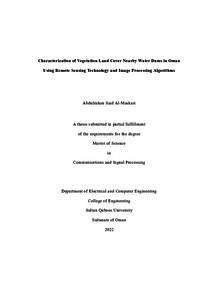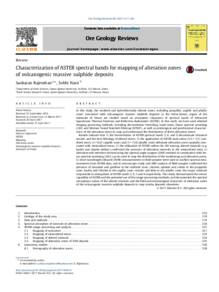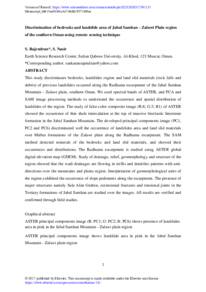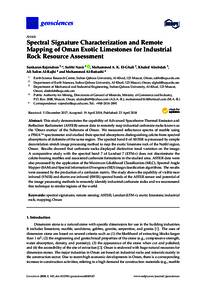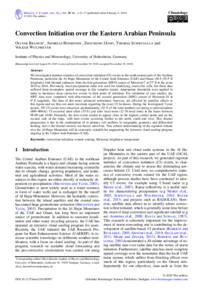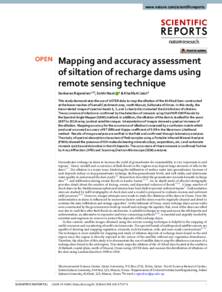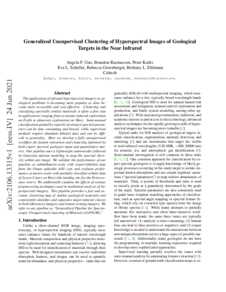Document
Characterization of vegetation land cover nearby water dams in Oman using remote Sensing technology and image processing algorithms.
Other titles
توصیف الغطاء النباتي القریب القریبة من السدود في عمان باستخدام تقنیات الاستشعار عن بعد وخوارزمیات معالجة الصور
Publisher
Sultan Qaboos University.
Gregorian
2022
Language
English
Subject
English abstract
Remote sensing technology plays a significant role in monitoring and understanding climate transition,
plant diversity, reservoir water, and vegetation status across the globe. Remote sensing is a very useful
non-invasive tool for researchers, engineers, and earth scientists, due to its diverse sensing capabilities
from far-distant space to characterize earth's surface resources over vast areas and over time. Besides,
steady technical advancements to space-borne earth observation sensor resolution and scanning
capability have resulted in transformational shifts in our ability to understand ecosystem conditions,
especially with state-of-the-art remote sensing platforms of high spatial and spectral resolutions.
Water is a finite natural resource, and it requires continuous monitoring in order to implement strategies
and policies that ensure its long-term viability. Further, water dams are used to reduce water shortage.
In this thesis, with the support of remote sensing imagery data, geographic information system (GIS),
and MATLAB image processing toolbox, a comprehensive numerical study is conducted to investigate
and characterize the vegetation landcover as well as the water surface area in nearby water recharge
dams in Oman. The study area is extracted from remote sensing satellite imageries. Four earth
observation satellites were used exclusively in this study which are Landsat-5, Landsat-7, Landsat-8,
and sentinel-2. Multiple methods are applied and tested using ArcGIS software to visualize the
vegetation landcover and water surfaces. The main contribution of this research is the development of
engineering high-speed and robust scripts to investigate the vegetation land cover as well as the water
surface area in Oman over a long period. The developed computer scripts avoid unnecessary complex
retrieval procedures and can be reused for multiple applications. Moreover, this research study is a time
series analysis focused on the years between 1985 and 2020.
In this study, several water dams are considered as case study areas, including three groundwater
recharge dams, Naam, A'Rassah, and Uqiidah water dams. Those dams are located in a hot and drought
region in Ash-Sharqiyah North Governorate, wilāyāt Al-Qabil, in Oman. There are several methods
that were applied and tested in this research study. Several band composites are used to interpret the
study area. Also, the normalized difference vegetation index (NDVI) is used to detect the vegetation
land cover and liquid water surface areas. From image processing techniques, the hue, saturation, and
value (HSV) color representation is used for classification and segmentation. Moreover, MATLAB
scripts are also developed to aid in numerically estimating the two types of land cover. Additionally,
the spectral profiles of vegetation landcover nearby water dams are processed and analyzed.
The achieved results show that the average vegetation landcover was around 4.2 km2 in the first 17 years
from 1985 to 2002. In contrast, during the next seven years, from 2002 to 2009, the average land cover
decreased approximately to 3.6 km2
. Furthermore, the next four years, from 2009 to 2013, show a
noticeable change in the average vegetation landcover to reach around 4.6 km2
. In the last period,
between the years 2013 and 2020, the average increased significantly to reach around 8 km2
.
The findings from the analysis show the vegetation average land cover increased significantly by 89.9%
compared with the average vegetation land cover for the years before the dams were constructed.
Nevertheless, the mentioned water dams construction was done between 2009 and 2012. What stands
out in this is that the statistics show a significant vegetation land cover growth after the water dams are
constructed.
Member of
Resource URL
Arabic abstract
تساعد تكنولوجیا الاستشعار عن بعد في عملیات الرصد والتقدیر الدقیق لأنماط التحول المناخي، ومراقبة المسطحات المائیة، ومتابعة
أشكال التنوع النباتي وحالة الغطاء النباتي في جمیع أنحاء العالم، وتطبیقات أخرى كثیرة. ولذلك؛ فإن أدوات الاستشعار عن بعد تعد
مفیدة للغایة؛ لكونھا لا تتطلب التدخل المباشر من قبل الباحثین والمھندسین وعلماء الأرض، بفضل قدرات الاستشعار المتنّوعة على
ٍ متباین ومستمّر. علاوة على ذلك؛ فقد أدّت التطّورات التقنّیة توصیف موارد سطح الأرض على مساحات شاسعة وعلى مدى زمني
ھزة الاستشعار الأرضي الموجودة في الفضاء، وقدرتھا على المسح الدقیق؛ إلى تحّو الم لات كبیرة في قدرِتنا ّطردة المتمثلة في دقة أج
على فھم ظروف النظام البیئي؛ خصو ًصا مع أحدث من ّصات الاستشعار عن بعد ذات الدقة المكانّیة والطیفّیة العالیة.
ول ّما كان الماء موردا طبیعیا محدودًا، ویتطل مستمّرة من أجل تنفیذ الاستراتیجیات والسیاسات التي تضمن المحافظة علیھ على ّب مراقبة
المدى الطویل؛ فقد أنشئت السدود في عدد من المجاري المائیة لاستغلال ھذا المورد الطبیع ّي المھم، وللحدّ من نقص مستویات المیاه
الجوفّیة في باطن الأرض .من ھذا المنطلق؛ تھدف ھذه الأطروحة -من خلال بیانات صور الاستشعار عن بعد ونظام المعلومات
إلى إجراء دراسة عددّیة؛ لاستكشاف وتمییز الغطاء النبات ّي الجغرافیة (GIS (وأداة معالجة الصور بواسطة برنامج -MATLAB ؛
بالإضافة إلى دراسة مساحة أسطح المیاه في المناطق القریبة من السدود في سلطنة عمان. أ الدراسة بتحلیل البیانات المستخرجة ُجِرَی ْت
من مج ّسات الأقمار الصناعیة للاستشعار عن بعد، وقد تم تحلیل بیانات أربعة أقمار صناعیة لرصد الأرض، ھي -5Landsat
و-7Landsat و-8Landsat و -2Sentinel. فقد تم اختبار وتطبیق طرق متعددة باستخدام برنامج ArcGIS لإظھار الغطاء النباتي
والأسطح المائیة .یتمثل الإسھام الأساسي لھذه الأطروحة في تطویر وھندسة نصوص برمجّیة عالیة السرعة لحساب الغطاء النباتي والأسطح المائیة في ُ تخدامھا في َمّكن من إعادة اسعمان على مدى فترة زمنیة طویلة، بحیث تتجّنب النصوص البرمجیة المطّورة الإجراءات المعقدة؛ مما یعد تطبیقات متعددة بطریقة سلسة. وتبعا لذلك؛ سعت ھذه الدراسة إلى تحلی ٍل متسلسل زمن�یا یر ّكز على السنوات ما بین 1985 و،2020
حیث تم اختیار ثلاثة سدود مائیة بوصفھا عینة للدراسة، تقع ھذه السدود في ولایة القابل بمنطقة شمال الشرقیة بسلطنة عمان، وھي: سدّ
وادي نام، وسد الرسة، وسد العقیدة .اعتمد البحث خطوات إجرائیة متعددة؛ إذ استخدم العدید من مكونات النطاق الترددي لتفسیر منطقة الدراسة؛ كما استفاد البحث من مؤشر الفرق المعیاري للغطاء النباتي (NDVI (بھدف الكشف عن الغطاء الأرضي؛ للتمییز بین الغطاء النباتي والاسطح المائیة. كما تم - عبر تقنیة معالجة الصور - استخدام نظام تمثیل الألوان الصبغة والتشبع والقیمة (HSV (للتصنیف والتجزئة. وبالإضافة إلى ذلك؛ فقد تم تطویر النصوص الرقمّیة باستخدام برنامج MATLAB للمساعدة في التقدیر العددي للغطاء النباتي والمسطحات المائیة. وقد تم التحقق من البصمة الطیفیة للنباتات الواقعة قرب السدود .أظھرت النتائج التقدیریة أ ّن متوسط الغطاء النباتي في الـ 17 سنة الأولى من 1985 إلى 2002 ھو 4.2 كیلومتر مربع. في المقابل، وخلال السنوات السبع التالیة من 2002 إلى ،2009 انخفض المتوسط إلى 3.6 كیلومتر مرب ع. بینما أظھرت السنوات الأربع من 2009 تغیرا ملحوظ 4.6 كیلومتر مربع؛ في حین ارتفع المتوسط بشكل ملحوظ بین عامي 2013 و،2020 إلى 2013 ا في المتوسط لیصل إلى لیصل إلى 8 كیلومتر مربع .تظھر نتائج التحلیل أن متوسط الغطاء النباتي زاد بشكل ملحوظ بنسبة ٪89.9 مقارن ة بمتوسط الغطاء النباتي للسنوات التي سبقت إنشاء السدود. وحیث إ ّن السدود المذكورة قد أنشئت بین عامي 2009 و 2012؛ فإن نتائج الدراسة قد أظھرت من التقدیرات الإحصائیة نمًوا كبی ًرا في الغطاء النباتي بعد إنشاء السدود.
أشكال التنوع النباتي وحالة الغطاء النباتي في جمیع أنحاء العالم، وتطبیقات أخرى كثیرة. ولذلك؛ فإن أدوات الاستشعار عن بعد تعد
مفیدة للغایة؛ لكونھا لا تتطلب التدخل المباشر من قبل الباحثین والمھندسین وعلماء الأرض، بفضل قدرات الاستشعار المتنّوعة على
ٍ متباین ومستمّر. علاوة على ذلك؛ فقد أدّت التطّورات التقنّیة توصیف موارد سطح الأرض على مساحات شاسعة وعلى مدى زمني
ھزة الاستشعار الأرضي الموجودة في الفضاء، وقدرتھا على المسح الدقیق؛ إلى تحّو الم لات كبیرة في قدرِتنا ّطردة المتمثلة في دقة أج
على فھم ظروف النظام البیئي؛ خصو ًصا مع أحدث من ّصات الاستشعار عن بعد ذات الدقة المكانّیة والطیفّیة العالیة.
ول ّما كان الماء موردا طبیعیا محدودًا، ویتطل مستمّرة من أجل تنفیذ الاستراتیجیات والسیاسات التي تضمن المحافظة علیھ على ّب مراقبة
المدى الطویل؛ فقد أنشئت السدود في عدد من المجاري المائیة لاستغلال ھذا المورد الطبیع ّي المھم، وللحدّ من نقص مستویات المیاه
الجوفّیة في باطن الأرض .من ھذا المنطلق؛ تھدف ھذه الأطروحة -من خلال بیانات صور الاستشعار عن بعد ونظام المعلومات
إلى إجراء دراسة عددّیة؛ لاستكشاف وتمییز الغطاء النبات ّي الجغرافیة (GIS (وأداة معالجة الصور بواسطة برنامج -MATLAB ؛
بالإضافة إلى دراسة مساحة أسطح المیاه في المناطق القریبة من السدود في سلطنة عمان. أ الدراسة بتحلیل البیانات المستخرجة ُجِرَی ْت
من مج ّسات الأقمار الصناعیة للاستشعار عن بعد، وقد تم تحلیل بیانات أربعة أقمار صناعیة لرصد الأرض، ھي -5Landsat
و-7Landsat و-8Landsat و -2Sentinel. فقد تم اختبار وتطبیق طرق متعددة باستخدام برنامج ArcGIS لإظھار الغطاء النباتي
والأسطح المائیة .یتمثل الإسھام الأساسي لھذه الأطروحة في تطویر وھندسة نصوص برمجّیة عالیة السرعة لحساب الغطاء النباتي والأسطح المائیة في ُ تخدامھا في َمّكن من إعادة اسعمان على مدى فترة زمنیة طویلة، بحیث تتجّنب النصوص البرمجیة المطّورة الإجراءات المعقدة؛ مما یعد تطبیقات متعددة بطریقة سلسة. وتبعا لذلك؛ سعت ھذه الدراسة إلى تحلی ٍل متسلسل زمن�یا یر ّكز على السنوات ما بین 1985 و،2020
حیث تم اختیار ثلاثة سدود مائیة بوصفھا عینة للدراسة، تقع ھذه السدود في ولایة القابل بمنطقة شمال الشرقیة بسلطنة عمان، وھي: سدّ
وادي نام، وسد الرسة، وسد العقیدة .اعتمد البحث خطوات إجرائیة متعددة؛ إذ استخدم العدید من مكونات النطاق الترددي لتفسیر منطقة الدراسة؛ كما استفاد البحث من مؤشر الفرق المعیاري للغطاء النباتي (NDVI (بھدف الكشف عن الغطاء الأرضي؛ للتمییز بین الغطاء النباتي والاسطح المائیة. كما تم - عبر تقنیة معالجة الصور - استخدام نظام تمثیل الألوان الصبغة والتشبع والقیمة (HSV (للتصنیف والتجزئة. وبالإضافة إلى ذلك؛ فقد تم تطویر النصوص الرقمّیة باستخدام برنامج MATLAB للمساعدة في التقدیر العددي للغطاء النباتي والمسطحات المائیة. وقد تم التحقق من البصمة الطیفیة للنباتات الواقعة قرب السدود .أظھرت النتائج التقدیریة أ ّن متوسط الغطاء النباتي في الـ 17 سنة الأولى من 1985 إلى 2002 ھو 4.2 كیلومتر مربع. في المقابل، وخلال السنوات السبع التالیة من 2002 إلى ،2009 انخفض المتوسط إلى 3.6 كیلومتر مرب ع. بینما أظھرت السنوات الأربع من 2009 تغیرا ملحوظ 4.6 كیلومتر مربع؛ في حین ارتفع المتوسط بشكل ملحوظ بین عامي 2013 و،2020 إلى 2013 ا في المتوسط لیصل إلى لیصل إلى 8 كیلومتر مربع .تظھر نتائج التحلیل أن متوسط الغطاء النباتي زاد بشكل ملحوظ بنسبة ٪89.9 مقارن ة بمتوسط الغطاء النباتي للسنوات التي سبقت إنشاء السدود. وحیث إ ّن السدود المذكورة قد أنشئت بین عامي 2009 و 2012؛ فإن نتائج الدراسة قد أظھرت من التقدیرات الإحصائیة نمًوا كبی ًرا في الغطاء النباتي بعد إنشاء السدود.
Category
Theses and Dissertations

